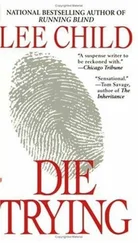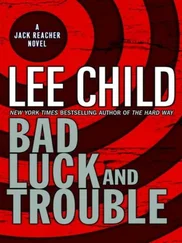Lee Child - A Wanted Man
Здесь есть возможность читать онлайн «Lee Child - A Wanted Man» весь текст электронной книги совершенно бесплатно (целиком полную версию без сокращений). В некоторых случаях можно слушать аудио, скачать через торрент в формате fb2 и присутствует краткое содержание. Жанр: Детектив, на английском языке. Описание произведения, (предисловие) а так же отзывы посетителей доступны на портале библиотеки ЛибКат.
- Название:A Wanted Man
- Автор:
- Жанр:
- Год:неизвестен
- ISBN:нет данных
- Рейтинг книги:4 / 5. Голосов: 1
-
Избранное:Добавить в избранное
- Отзывы:
-
Ваша оценка:
- 80
- 1
- 2
- 3
- 4
- 5
A Wanted Man: краткое содержание, описание и аннотация
Предлагаем к чтению аннотацию, описание, краткое содержание или предисловие (зависит от того, что написал сам автор книги «A Wanted Man»). Если вы не нашли необходимую информацию о книге — напишите в комментариях, мы постараемся отыскать её.
Immediately he knows they're all lying about something – and then they run into a police roadblock on the highway. But they get through. Because the three are innocent? Or because the three are now four?
Is Reacher a decoy?
A Wanted Man — читать онлайн бесплатно полную книгу (весь текст) целиком
Ниже представлен текст книги, разбитый по страницам. Система сохранения места последней прочитанной страницы, позволяет с удобством читать онлайн бесплатно книгу «A Wanted Man», без необходимости каждый раз заново искать на чём Вы остановились. Поставьте закладку, и сможете в любой момент перейти на страницу, на которой закончили чтение.
Интервал:
Закладка:
Then he walked the depth of the garage space and tried the new door in the plywood end partition. It opened into the same kind of long, narrow central corridor. Rooms to the left, rooms to the right. The centre vault, colonized just like the first vault. Some of the doors had blue spots on them. Plastic circles, cut out and glued on. The second room on the left and the second room on the right both had one. That pattern repeated every three rooms as far as the eye could see.
Reacher checked behind him. The door he had come through had two blue spots.
He listened hard and heard nothing. He took a breath and counted to three and set off walking. To the second door on the right. A cheap store-bought item. With a thin chrome handle. And a blue spot, at eye level.
He turned the thin chrome handle. He pushed open the door. A room, of decent size. Empty. No people. No furniture. No nothing, except what had been there all along, which was another original door through the side wall. It was identical to the first two he had seen, with the complex cast frame like a tunnel all its own, and the pale old laminate facing, and the heavy steel handle. Clearly the blue spot meant a way through, side to side. A shortcut, from chamber to chamber. For busy people. The garage door got two blue spots because it had ways through both left and right. The lateral access was an efficiency measure. Both now, apparently, and certainly back when missiles roamed the earth. It would have been time-consuming for a technician to walk the whole length of the building and go outside and then come back in down a different tunnel. Far better to facilitate a little crosstown traffic. Maybe every sixty feet or so. Some guy with a clipboard would have figured that out, long ago. The architects would have gotten to work, with drafting tables and sharpened pencils, and load factors calculated with slide rules and guesswork.
Reacher was in a room on the right-hand side of the row. And just like the door he had seen on the right in the garage, this door on the right was also covered over with thick see-through plastic, which was also stuck down very carefully at the edges with duct tape. Lots of it.
Purpose unknown.
He had two motel keys in his pocket. One from the fat man’s place in Iowa, and one from the FBI’s quarantine spot in Kansas. The fat man’s key was sharper. The tang at the end had been left pretty rough by the key-cutting process. Maybe the key was a replacement. Maybe some guest had headed home with the original still in his pocket, and maybe the fat man’s policy was to use the cheapest services he could find.
Reacher pressed the see-through plastic against the faded old laminate behind it, and he scratched at it with the tip of the key. The key snagged and jumped and made pulls and blisters. The blisters went thin and puffy and the second go-round with the key started a hole in one of them. Reacher got the tip of the key in the hole and sawed away at it, cutting where he could, stretching and tearing where he couldn’t. When the slit reached three inches long he put the key back in his pocket and hooked his fingers in the slit, palms out, and forced his hands apart.
The plastic was tough. Some kind of heavy grade. Not like the tissue-thin stuff he had seen painters use as drop cloths. More like shrink wrap. He had seen people struggling with it. Supermarkets should sell switchblades, right next to the salami. He got the slit about twelve inches long and the tension went out of it. He had to start a new cut with the key. He learned from that experience. He changed his technique, to a rhythmic cut-yank-cut-yank sequence, with the key in his mouth between cuts. Eventually he got it done, more or less all the way from top to bottom, very stretched and ragged, but big enough to force himself through.
He put his arm through the hole and turned the heavy steel handle and pushed the door with his fingertips. Nothing but darkness beyond. And cold air. And a silent acoustic suggestive of vast space and hard walls.
He turned sideways and forced himself through the slit in the plastic, leading with the Glock, then his right foot, then his right shoulder, ducking his head, pulling his left arm and his left foot after him. He used touch and feel, tracing the shape of the cast frame around the door, closing the door behind him, searching for a light switch. He knew there would be one. Those old-time architects with their drafting tables and their sharpened pencils would have been plenty thorough. The electrical plans would have been a whole separate sheaf of blueprints.
He found an electric conduit on the wall. Steel pipe, thickly painted, cold to the touch, covered in dust. He traced it back to a square metal box, maybe four inches by four, with a dimple on its front face, and a cold brass toggle in the dimple.
He turned the lights on.
SEVENTY-THREE
THE THIRD CHAMBER was not subdivided. It was in its original state. It was a tunnel, roughly semicircular in section, forty feet wide, maybe four hundred feet long, just over head high at the side walls, perhaps thirty feet tall at the peak of the vaulted ceiling. It was formed from concrete, poured and cast like the outside, with wood grain showing here and there, with stepped curves, with thin ragged ribs and seams where the formwork had leaked. It was unpainted, but no longer raw. It was mellow and faded and dusty, after many patient decades. It had a blank wall at the far end, and it had blastproof doors at the near end, with a mechanism exactly like the one Reacher had used in the centre chamber.
It was not empty.
All along the centre of the space was a nose-to-tail line of enormous flatbed semi trailers. No tractor units. Just the trailers, one after the other, like a traffic jam on the highway. Each trailer was close to fifty feet long and twelve feet wide. There were eight of them. Each of them had four load-bearing axles at the rear, and two huge cantilevered arms at the front, first rearing up at a steep angle, and then reaching forward at a shallower angle, ready to latch into the tractor unit, like gigantic insect antennas.
They were all painted the colour of sand. Desert camouflage base coat. Reacher knew exactly what they were. They were components from the army’s HET system. Heavy Equipment Transporter. This particular type of trailer was called the M747. Its matching tractor unit was called the M746. Both had been built by the Oshkosh Corporation in Wisconsin. Both had been taken out of front-line service after the Gulf War in 1991. Neither had proved sufficiently durable. Their task had been to haul Abrams battle tanks around. Battle tanks were built for tank battles, not for driving from A to B on public roads. Roads got ruined, tracks wore out, between-maintenance hours were wasted unproductively. Hence tank transporters. But Abrams tanks weighed more than sixty tons, and wear and tear on the HETs was prodigious. Back to the drawing board. The old-generation hardware was relegated to lighter duties.
But in this case, not much lighter.
Each of the eight trailers was loaded with a nose-to-tail pair of flasks or vats or containers. For some kind of liquid, clearly. But really big. Tens of thousands of gallons. Each unit was the size of four Volkswagens stacked two on two, like bricks. The size of a small room. They were made of steel, rolled and folded and hydroformed, and welded, like squat fat bottles, with a protective frame all around, the function of the bottle and the function of the frame so well integrated it was hard to see where one finished and the other began. Overall they were like rounded-off cubes, about twelve feet long, by twelve feet wide, by twelve feet high, reinforced in places for strength and durability. The steel looked thick and solid. Maybe it was backed with an extra mineral layer. An innovation.
Читать дальшеИнтервал:
Закладка:
Похожие книги на «A Wanted Man»
Представляем Вашему вниманию похожие книги на «A Wanted Man» списком для выбора. Мы отобрали схожую по названию и смыслу литературу в надежде предоставить читателям больше вариантов отыскать новые, интересные, ещё непрочитанные произведения.
Обсуждение, отзывы о книге «A Wanted Man» и просто собственные мнения читателей. Оставьте ваши комментарии, напишите, что Вы думаете о произведении, его смысле или главных героях. Укажите что конкретно понравилось, а что нет, и почему Вы так считаете.











![Paul Finch - A Wanted Man [A PC Heckenburg Short Story]](/books/702381/paul-finch-a-wanted-man-a-pc-heckenburg-short-sto-thumb.webp)
